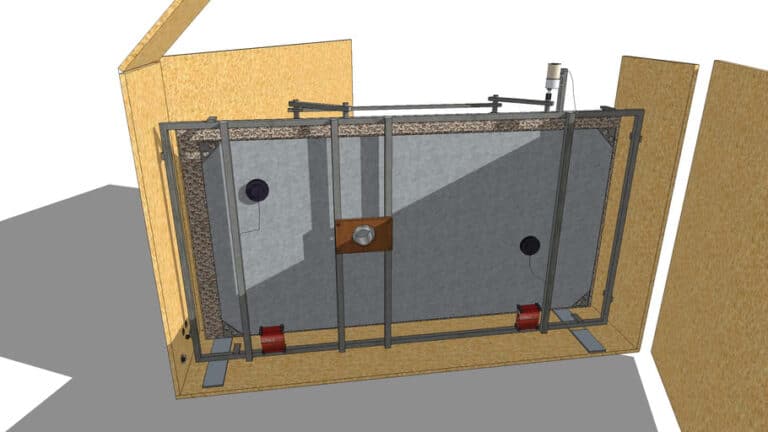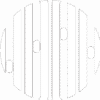Last Updated on December 8, 2022 by IDS Team
Any guide to using plate reverb needs to show you how sound works. Ever looked at the different reverbs on your DAW and wanted to understand them better? In this article, we go into plate reverb, why it is one of the most interesting kinds of reverb, and how to use it on guitar. Read on to find out more.
What Is Plate Reverb?
Plate reverb, like any reverb, is an effect which you add to a dry track. This is designed to give the dry recording a more natural sound, However, plate reverbs themselves don’t attempt to be true to nature. Unlike other kinds of reverb, no plate reverb ever tries to copy real-life reverb in a specific kind of space. Instead, plate reverb plugins are modelled off physical plate reverbs, where sound passes through a metal plate made of one of any different metals, often steel. The vibrations are picked up by a microphone, and they travel down the rest of the signal chain.
Guide to Plate Reverb: How Does It Work?
To understand more about plate reverb, it helps to know why mix engineers add reverb in the first place. When engineers mix sounds, the soundproofing of the studio ensures the sound is very dry. At this stage, it lacks both reverb, and delay.
However, listeners need reverb. It’s everywhere, regardless of whether you’re in a concert hall or a church. As a result, tracks sound strange without it. Therefore, in the first analogue recording studios. producers and engineers found ways to add reverb artificially, and one of the best-loved of these is plate reverb. This works by suspending a metal plate within a container via springs, which vibrates as sound hits it, and a microphone amplifies the resulting soundwaves. These then go back down the signal chain. Due to the way sound interacts with the plate, plate reverb at first very bright. It only becomes much dimmer and darker towards the tail end of the sound wave.
You can hear plate reverb on many ’60s and ’70s recordings. In fact, Abbey Road studies actually contributed to their popularity. Their brightness adds an ethereal sound. Meanwhile, their character comes from the darker frequencies they carry.
What Options Are On the Market?
Physical plate reverbs are incredibly expensive to own in real life. On their Dark Side of the Moon album, Pink Floyd actually used a version of the world’s first plate reverb, created by German company EMT, who called it the EMT 140.
However, like other parts of the analogue studio, they are now easy to mimic digitally. Below is a quick guide to plate reverb plugins which are affordable for the average musician:
Reverbs:
- Soundtoys Little Plate – 99 USD
- Arturia Rev Plate-140 – 100 USD
- Valhalla Plate – 50 USD
- Black Rooster Audio RO-140 – 29 USD
- Variety of Sound epicPlate – FREE
Plugins which contain plate reverb:
- Relab Development LX 480 – 99 USD
- IK Multimedia T-RackS Sunset Sound Studios Reverb – 61 USD

Most plugins can be bought on Pluginboutique.com and if you use this link to make a purchase you are helping us a lot because we get a small kickback.
Plate Reverb in Recording: An Introduction
You may have most commonly heard of plate reverb used for vocals or drums. This is because of the high frequency of sonic vibrations in metal. In fact, this is where their smoothness and brightness come from. Another place you might hear them used is on strings. But what about for guitar? Plate reverb is best known for adding a spooky or ethereal tone. It’s great for psychedelic guitar, as well as for guitar solos. It is also very useful for creating a sense of atmosphere. Your guitar by itself might not sound hugely atmospheric, but if you’re working without much other gear or software, a good plate reverb plugin can do a lot can boost the levels of sonic interest infinitely.
Classic Psychedelic Sounds: Plate Reverb Ideas and How-To
When using plate reverb in recording, keep in mind its ethereal sound and its brightness. It is great if you want to add some shine to mid-frequency heavy guitar and riffs – perfect if you want your guitar to pop out in contrast to your bass frequencies to prevent things from sounding muddy.
However, plate reverb can really come into its own on softer lead guitar lines. Solos in slow tracks can benefit from it, and Dark Side of the Moon is a great example. It’s good for rock, pop, indie, and any experimental guitar. It’s not as great for metal, hard rock or punk, although it can be used. Its tendency to blur all reverberations together does give it a rather alien sound. Therefore, if you really want to get more out of it, the trick is to combine it with something else. Some good combinations are:
- plate reverb blended in at a low level with a chamber reverb. A chamber reverb has as much of an unusual vibe, but is a bit more natural.
- plate reverb combined with hall reverb. To amplify the dramatic effect of the plate reverb’s otherworldliness, combine it with a big hall reverb.
- plate reverb with room reverb. For a classic sound, especially on a more low key track, mix plate reverb with a room reverb. Blend the plate reverb in at a low level so as not to be overpowering.
Guide to Plate Reverb: What Else Is Good to Know?
If you are more used to sound in the real world, think of plate reverb in general as an effect like you would get in your pedals. Don’t try to think of it as mimicking physical echoes and reverberations. Without getting into how it works, remember it’s the darkest, spaciest reverb. As it’s less natural, it’s best to use it when you want to modify your guitar for something more atmospheric. Alternatively use it in tandem with any of the reverbs which mimic a natural space (room, hall, chamber). However, plate reverb is a great gateway to using your plugins and DAW as an instrument in itself. This can be one of the most challenging things for guitarists, who sometimes feel more comfortable with a physical instrument. However, this is a great place to start.
Final Thoughts
So there you have it – a quick introduction to plate reverb. This is how it works, and the best contexts in which to use it. With more understanding and time, it can become a staple tool for your production. In fact, different reverbs really expand the range of sounds you can apply to your guitar during the mixing process. Just keep in mind their unique qualities. This means that you’ll be able to judge where this reverb, like any, adds to your guitar – or when to leave it. When used correctly, it is a very intense and interesting effect. As a result, even exploring it a little can totally alter the way you think about your sound.
Liked this article? We have more in our tutorials section here.



